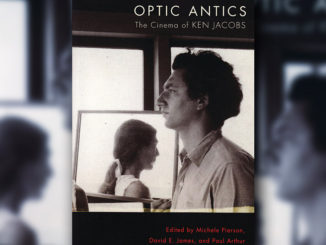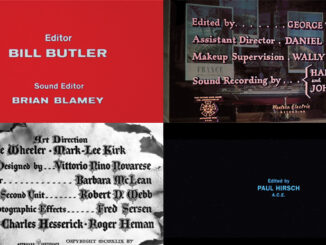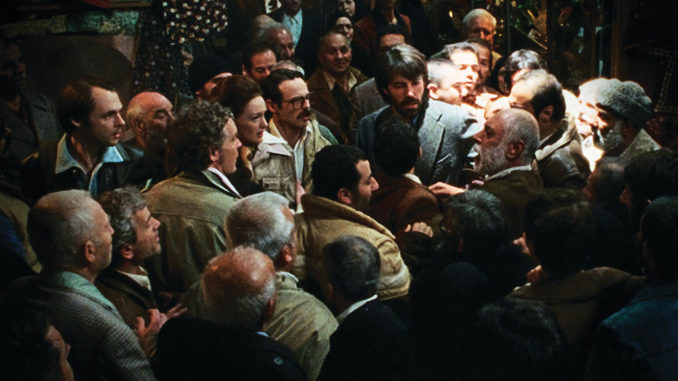
by Michael Goldman
William Goldenberg, A.C.E., enjoyed his stint on Ben Affleck’s Argo as a comfortable return to a budding collaborative relationship that he began with Affleck in 2007 on the filmmaker’s first movie, Gone Baby Gone (2007). His schedule didn’t permit him to work on Affleck’s second directorial effort, The Town(2010), but Goldenberg was ecstatic to reunite with him for Argo.
That’s because Affleck has a “particularly clear mind” when it comes to the editing process and understanding his editor’s needs while he is shooting, according to Goldenberg. “Ben is quite technically savvy and has done a fair amount of editing himself over the years,” he says. “He’s been around the movie business a long time and prides himself in knowing all aspects of the filmmaking process.”
But on Argo — a Warner Bros. release that has been in theatres since mid-October and has generated considerable Oscar buzz — Goldenberg could tell that the director’s confidence had increased. “When we were done editing, there were not a lot of pieces of film unused,” he recalls. “He understood exactly what he wanted to do from the day he started shooting, and had worked to get a finely honed script from screenwriter Chris Terrio. So there were no giant, action beats we had to later take out. The process was more about fine-tuning those beats.”
Argo was the first of two award candidates that Goldenberg participated in editing in the last year. After the project ended, he was invited by director Kathryn Bigelow to join Dylan Tichenor, A.C.E., in cutting her acclaimed new film on the hunt for Osama bin Laden: Zero Dark Thirty. That movie was digitally acquired on Arri Alexa cameras and featured an all-digital workflow that literally resulted in millions of ARRIRAW images to cull through that would have amounted to, in Goldenberg’s estimation, about 1.8 million feet of film. Consequently, to get it all done within the project’s time window, Goldenberg was belatedly asked to co-edit with Tichenor toward the end of shooting. He started with the climactic raid on the Bin Laden compound before moving on to other sections of the film.
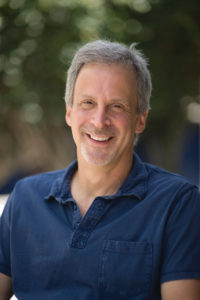
Tichenor and Goldenberg were given the LA Film Critics’ first ever award for Best Editing. Runner-up was Goldenberg for Argo.
But of the two movies, Argo was the one that Goldenberg participated in from the outset. That movie was cut entirely at the production’s Los Angeles office on Avid 5.0.4 workstations with well over 20 TB of Avid Unity storage and everything redundant to an identical system installed in Affleck’s home. EFilm’s CinemaScan data managed dailies workflow system was used to generate dailies, churning out Avid DNxHD 115 media files for editorial in a process that Goldenberg and his lead assistant, Brett Reed, both say was fairly standard with typical turnaround during most of the production.
Argo is a deft mixture of drama, thriller and comedy elements that details a true story that was once called “The Canadian Caper” — events in 1979 in which six American Embassy workers who escaped the takeover of the US Embassy in Iran took refuge in the home of the Canadian ambassador. There, they nervously waited until the CIA, working with the Canadians, concocted the most offbeat of covert operations to finally whisk them out of the country under the noses of Iran’s Revolutionary Guards almost a month after they first took refuge. That operation involved sending in CIA covert operative Tony Mendez (played by Affleck) to lead them out under the guise of being a Canadian film crew scouting for locations for a cheesy science fiction movie.
The setup means significant portions of the movie take place in three different “worlds”: Iran, CIA headquarters in Langley, Virginia, and Hollywood, where Mendez travels to set up a real movie production company and a back story to help fool the Iranians. Each of those worlds was strategically designed to look somewhat different. In fact, according to Goldenberg, Affleck studiously researched period films from the late ‘70s era and loosely used a few such films as visual templates for different sections of the movie. All the President’s Men (1976), for example, offered up ideas for how to visualize the CIA bullpen where analysts would toil around the clock.
But regardless of the locale, Affleck always gave Goldenberg free reign to cut those sections for maximum emotion. “There was no self-imposed style about each section,” he explains. “I was mostly cutting for story and performance, and the way it was shot predisposed a lot of the style. Ben and cinematographer Rodrigo Prieto shot the sections involving CIA headquarters during the escape sequences, for instance, with longer Steadicam shots, so those kinds of shots had less coverage than, say, the footage of the escaped Embassy workers in Iran. They shot the Iran stuff [in Istanbul, Turkey] on two-perf, 35mm to have a grainier, more aged look, whereas the material in the U.S. was shot on 4-perf.”
Argo also includes a fair amount of footage shot in 8mm or 16mm. “Wild stuff was captured that way, particularly for the Embassy takeover scene,” the editor continues. “So all of those choices in production impacted how I felt about the footage, and therefore, how I cut it. The juxtaposition of the longer, more traditional shots versus the more frenetic, grainier coverage originally made us nervous, but it turned out to be great for the film.”
Tense Moments
Indeed, the stress-inducing Embassy takeover sequence that begins the movie was designed to replicate the movement, energy and sounds of the original event, but the filmmakers decided not to demonstrate that with stock footage during the opening sequence. Instead, Affleck wanted to take viewers deeper inside the crowd and the Embassy than would be possible with stock footage. The sequence was shot in a way designed to give Goldenberg plenty of puzzle pieces with which to work.
“He had camera operators [including both Prieto and Affleck himself] in the crowd [of extras playing Iranian students] with hand-held 8mm and 16mm cameras grabbing wild stuff, and we used a lot of that because it was so real,” Goldenberg explains. “The intention with that scene was to leave the audience breathless — like they would be if they were actually there. We tried to create that essence. The original script had more of the A-B-C of the events, but we cut it to be more visceral and immediate. And as we did that, the better it got.”
The other key strategic decision about cutting that sequence together was to avoid using music during the invasion of the Embassy. “We wanted only real sounds to induce tension,” Goldenberg adds. “We used hard-edged sound cuts from location to location to give the sequence a rough and disturbing feel. Our sound people [supervising sound editor and sound designer Erik Aadahl and re-recording mixers John Reitz and Gregg Rudloff] did a great job re-creating a lot of what it sounded like at the Embassy. All the sounds were original recordings for our movie; the detail was incredible. We used that as music, and it was more effective.”
“The idea was to access the Tony Mendez character’s emotions, to let the audience see him pulled apart as he goes through a decision-making process. I was trying to show the passage of time, that he was up all night.Then, there is a key moment when he decides what he is going to do. As an editor, I was trying to find pieces of film that show his eyes at that moment, and everything he was going through.” – William Goldenberg
The strategy to subtly use — or not use — music to heighten tension was employed in other crucial sequences. When the “houseguests,” as they are called in the film, go on a trial run to “scout a location” at a packed outdoor bazaar in Tehran (filmed at the Grand Bazaar in Istanbul), the sounds of the bazaar and, eventually, shouts of enraged Iranians are strategically employed to heighten tension. And on the way to the bazaar, as the houseguests drive through a massive student demonstration, their van is surrounded and pounded upon; once again, those are the only sounds the sequence requires. On the other hand, pieces of composer Alexandre Desplat’s score were woven into the elements of the sequence that cut away from the bazaar and back to events at the Canadian ambassador’s house, where suspicious Iranian authorities confront the ambassador’s housekeeper.
“In the bazaar, it was sound effects, just tonal landscapes, to make you feel like a fish out of water,” Goldenberg says. “And we purposely did not subtitle anything that was said in Farsi. We never used subtitles unless the audience needed to know something specific that was being said in order to follow the story. We wanted the audience to feel like the houseguests felt — an onslaught of noise in a foreign language they don’t understand, with the confusion and craziness of that experience — to put the audience in the shoes of the characters.
“It was the same thing in the van, where they are trapped,” the editor continues. “Ben had been in situations in cars in foreign countries where people were banging on his car, and he wanted us to illustrate the claustrophobia and fear that it causes as they are slapping on the metal and screaming. The cuts from the interior to the exterior are jagged and rough, quick whip pans, and flashes of people’s angry faces. Putting it all together gives you an oppressive kind of feeling. But in other places, Alexandre Desplat’s musical compositions were crucial. It’s just that it wasn’t typical action music — it was textured and subtle to help us build the tension.”
The movie’s climax heightens that tension even more. The disguised houseguests and Affleck’s character have to navigate a slow journey through layers of slow bureaucracy and suspicious and jumpy security guards at Tehran Airport in order to make their way to their boarding gate and onto their plane.
As this process plays out, it evolves into the kind of sequence where “every time you think they have cleared one hurdle, there is another,” according to Goldenberg. Along the way, he also had to weave into the sequence the simultaneous race by Iranian authorities to figure out who the houseguests were and then desperately try to catch up to them before they slipped out of the country.
“It all comes to a head rapidly,” he explains. “We were constantly juggling pieces around to make the timing work. We had to find the right pieces revealing how scared the houseguests were and what jeopardy they were in. We had to make that real — again with only subtle music. Mainly, it was real airport sounds. At the beginning, I tested it out with some temp action music, but I realized the piece had to be low-tension the whole time, making audiences get closer and closer to the edge of their seats.”
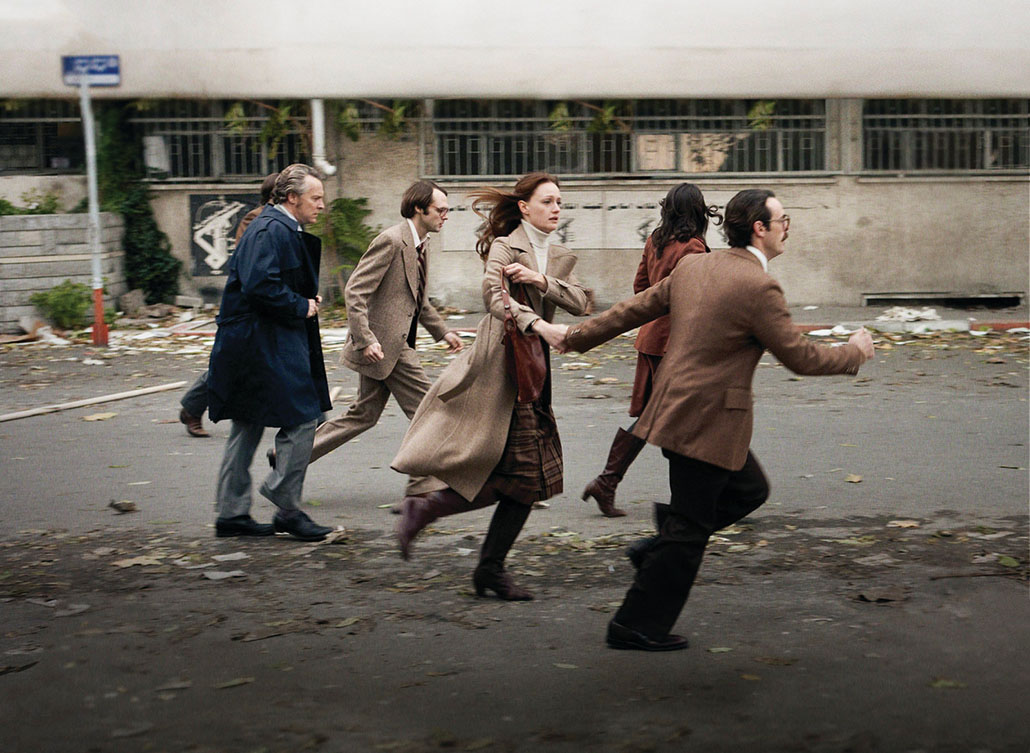
Courtesy of Warner Bros. Pictures
Subtle Emotion
Argo is filled with key sequences that have that kind of slow-build tension, but there are other scenes that are even subtler. Since the houseguests spend most of the film cooped up in a single building, and Affleck’s character spends lots of time thinking about their fate, his responsibilities to them and how he can help them, the filmmakers wove into the fabric tense, cerebral moments in which little is happening beyond conversation: furtive glances, close-ups and body language as the characters wait, think and worry. In some ways, Goldenberg suggests those sections were harder to put together.
“Again, I have to credit Ben in terms of the houseguests,” he says. “What he did that was so smart was to have those actors live together for a week in the house where they were going to film — no phones or computers or contact outside the house. They were studying each other and developing relationships and a rapport, depending on their ages and politics and so on. When their sequences were filmed, those already formed relationships gave the footage an authenticity that we otherwise wouldn’t have had.”
A key scene in the movie shows Affleck’s character at a crossroads, cooped up in his hotel room, drinking and pondering if he should obey his orders or risk everything to help the houseguests. The sequence runs a couple minutes and shows nothing more than Affleck shuffling around the room, staring out the window, drinking, gazing into space, lost in thought.
“That was an interesting piece to cut,” Goldenberg says. “The idea was to access the Tony Mendez character’s emotions, to let the audience see him pulled apart as he goes through a decision-making process. I was trying to show the passage of time, that he was up all night. Then, there is a key moment when he decides what he is going to do. As an editor, I was trying to find pieces of film that show his eyes at that moment, and everything he was going through. Each piece of film I chose — each one had a specific job to do.
“Whenever I cut a scene like that, I always cut it by feel,” he continues. “I watch those pieces and ask myself how they make me feel. I construct the sequence to put myself into the audience’s point of view and then, after the first cut, I try to see if I feel like I think the audience should feel. And I go over it again and again until I get that. But that certain moment of decision in Ben’s eyes — we combed through the footage over and over to find just the right moment.”
Therefore, Goldenberg built the scene around that one crucial piece of film where Affleck’s eyes reflect clearly his decision. “In general, I always try to first find what is the most real moment of the performance in the sequence and try to build the scene around that moment,” he emphasizes.
Zero Dark Thirty was a much different kind of thriller for the editor. “It was more documentary style, more raw,” he emphasizes. “Argo helped prepare me for it only in the sense that you get better on each project. But they are different animals, and it was a different situation [co-editing Zero Dark Thirty].” Goldenberg is used to co-editing, of course, particularly in his work on a few films for director Michael Mann.
“Typically, the movies I’ve done that were multi-editor were the Michael Mann movies, and [like Bigelow], he also shoots tremendous amounts of material,” Goldenberg says. “He makes hundreds of rounds of changes and screens the movie sometimes as much as six days a week. No one person can handle that kind of workload, and although we didn’t screen this film as frequently as [Mann] does, the same was true of Zero Dark Thirty. Generally, in such cases, we each take a section of the movie, and that is mostly what we did here, with most of my focus being on the climactic Bin Laden raid sequence.”
Ironically, though he cut Argo solo, the kind of work he did on that film reminds Goldenberg most of the material he cut several years ago on one of his highest profile efforts for Michael Mann: 1999’s The Insider, which he cut with David Rosenbloom, A.C.E., and Paul Rubell, A.C.E., which earned them both Oscar and ACE Eddie Award nominations.
“In both films, you are trying to keep the audience in the main character’s head space,” he says. “Everything is crashing down around him, and he’s trying to maintain. As an editor, it is more about the feel of things — whether to use music or not — and just a general sense of what would be the most tension-inducing material to include. It’s something I cannot fully explain; you just keep doing it until it feels right.
“Michael Mann likes to say that you try to find pieces that transcend the film — that make you feel like you are watching a real life,” Goldenberg continues. “As an editor, I’ve always tried throughout my career to find those moments and really let them breathe — and then build scenes around them.”



